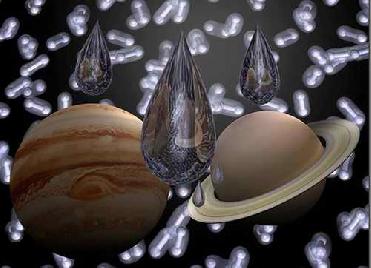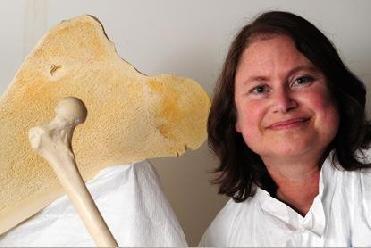
Lawrence Livermore National Laboratory illustration of the helium rain on the Jovian planets
NEW YORK (BNS): Physicists at Lawrence Livermore National Laboratory and the University of Illinois at Urbana-Champaign are working on models that may soon take on a different look of Saturn and Jupiter.
The physicists by determining the properties of hydrogen-helium mixtures at the millions of atmospheres of pressure present in the interior of Saturn and Jupiter have determined the temperature at a given pressure when helium becomes insoluble in dense metallic hydrogen. These results are directly relevant to models of the interior structure and evolution of Jovian planets, the physicists said.
�Hydrogen and helium are the two lightest and most common elements in the universe. Because of their ubiquitous nature, they are critical in cosmological nucleo-synthesis and are essential elements of stars and giant planets. Hydrogen by itself in the observable universe provides clues to the origin and large-scale structures of galaxies,� the researchers said.
However, scientists have struggled to determine what conditions are needed for the two elements to mix.
Using the first-principle molecular dynamics simulations, Miguel Morales, a DOE Stewardship Science graduate fellow from David Ceperley's group at the University of Illinois worked with LLNL's Eric Schwegler, Sebastien Hamel, Kyle Caspersen and Carlo Pierleoni from the University of L'Aquila in Italy to determine the equation of state of the hydrogen-helium system at extremely high temperatures (4,000-10,000 degrees Kelvin), similar to what would be found in the interior of Saturn and Jupiter.
The researchers used LLNL�s extensive high-performance computing facilities to conduct simulations over a wide range of density, temperature and composition to locate the equation of state of the two elements.
Morales said that the simulation results are consistent with the idea that a large portion of the interior of Saturn has conditions such that hydrogen and helium phase separate. �This can account for the apparent discrepancy between the current evolutionary models for Saturn and observational data,� Morales said.
Explaining the study, the researchers said that in addition to being made mostly of hydrogen and helium, a characteristic of Jovian planets is that they radiate more energy than they take in from the sun. �Various models of their evolution and structure have been developed to describe a relation between the age, volume and mass of the planet and its luminosity,� they said.
While this model works for Jupiter by modeling the energy radiation left over from its formation 4.55 billion years ago, it doesn't exactly work for Saturn. Instead, the model seriously underestimates the current luminosity of Saturn, the researchers said.
So the researchers for the first time determined where helium and hydrogen mix as well as at what temperature they don't mix.
Schwegler said that in this discovery it turned out the temperature where the two elements don't mix is high enough that helium is partially mixable over a significant fraction of the interior of the Jovian planets with the corresponding region of Saturn being larger than in Jupiter. �This, in fact, could change the current interior models of Saturn and Jupiter,� Schwegler said.
 Previous Article
Previous Article Next Article
Next Article













The Indian Air Force, in its flight trials evaluation report submitted before the Defence Ministry l..
view articleAn insight into the Medium Multi-Role Combat Aircraft competition...
view articleSky enthusiasts can now spot the International Space Station (ISS) commanded by Indian-American astr..
view article